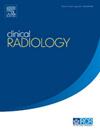566例周围性肺病变经皮穿刺穿刺活检:活检失败及术后气胸相关因素分析
IF 2.1
3区 医学
Q2 RADIOLOGY, NUCLEAR MEDICINE & MEDICAL IMAGING
引用次数: 0
摘要
目的评价经皮经胸穿刺穿刺活检(PCNB)检测周围性肺病变的安全性和有效性,探讨诊断失败和发生明显气胸的相关因素。材料和方法回顾性分析了2019年3月至2021年12月在单个中心进行的566例与内脏胸膜接触或邻近距离小于1cm的肺病变PCNB手术的数据。电子病历,包括住院病历、放射学报告和手术报告进行了审查。使用单因素和多因素logistic回归分析分析手术细节和病变特征,以确定诊断失败和术后气胸的相关因素。结果技术成功率为100%,诊断成功率为90.1%(510/566)。术后气胸发生率为19.4%(110/566)。需要延长住院时间的严重不良事件发生率为3.4%(19/566)。单因素和多因素分析显示,病变直径小于10 mm (p<0.001)与诊断失败有关,经裂路径(p = 0.042)和较长的气管道长度(p = 0.018)与术后气胸的发生有关。结论pcnb是一种安全有效的外周肺病变诊断方法,诊断成功率高,术后气胸发生率低。本文章由计算机程序翻译,如有差异,请以英文原文为准。
Percutaneous core needle biopsy of 566 peripheral lung lesions: analysis of factors associated with biopsy failure and postprocedural pneumothorax
AIM
To evaluate the safety and efficacy of percutaneous transthoracic core needle biopsy (PCNB) for peripheral lung lesions and to identify factors associated with diagnostic failure and occurrence of significant pneumothorax.
MATERIAL AND METHODS
Data from 566 PCNB procedures on lung lesions in contact with or adjacent to the visceral pleura at a distance less than 1 cm, performed at a single center between March 2019 and December 2021, were retrospectively reviewed. The electric medical records, including inpatient notes, radiology reports, and procedure reports were reviewed. Procedure details and lesion(s) characteristics were analyzed using univariate and multivariate logistic regression analyses to identify factors associated with diagnostic failure and postprocedural pneumothorax.
RESULTS
The technical and diagnostic success rates were 100% and 90.1% (510/566), respectively. Postprocedural pneumothorax occurred in 19.4% (110/566) of patients. The severe adverse events that required prolongation of the hospital admission occurred in 3.4% (19/566). Univariate and multivariate analyses revealed that lesion diameter less than 10 mm (p<0.001) was associated with diagnostic failure, and the transfissural route (p = 0.042) and longer tract length (p = 0.018) were associated with the occurrence of postprocedural pneumothorax.
CONCLUSION
PCNB was an effective and safe diagnostic method for peripheral lung lesions, with a high diagnostic success rate and low incidence of postprocedural pneumothorax.
求助全文
通过发布文献求助,成功后即可免费获取论文全文。
去求助
来源期刊

Clinical radiology
医学-核医学
CiteScore
4.70
自引率
3.80%
发文量
528
审稿时长
76 days
期刊介绍:
Clinical Radiology is published by Elsevier on behalf of The Royal College of Radiologists. Clinical Radiology is an International Journal bringing you original research, editorials and review articles on all aspects of diagnostic imaging, including:
• Computed tomography
• Magnetic resonance imaging
• Ultrasonography
• Digital radiology
• Interventional radiology
• Radiography
• Nuclear medicine
Papers on radiological protection, quality assurance, audit in radiology and matters relating to radiological training and education are also included. In addition, each issue contains correspondence, book reviews and notices of forthcoming events.
 求助内容:
求助内容: 应助结果提醒方式:
应助结果提醒方式:


